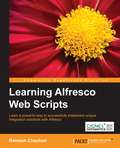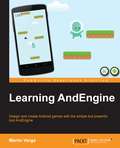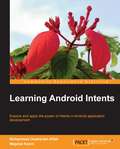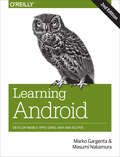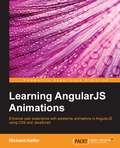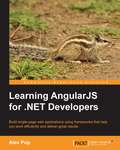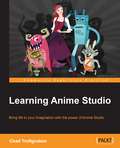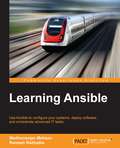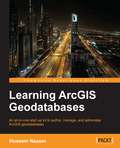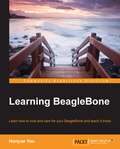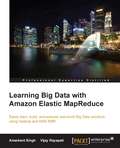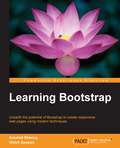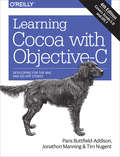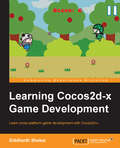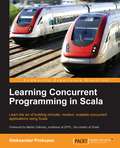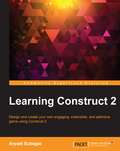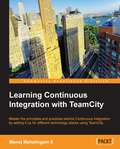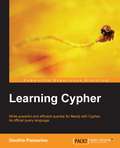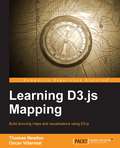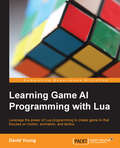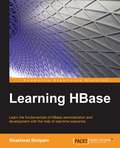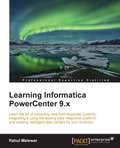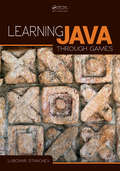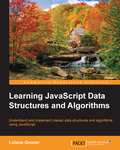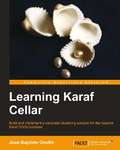- Table View
- List View
Learning Alfresco Web Scripts
by Ramesh ChauhanIf you are an Alfresco developer who has no experience with web scripts and you want to start developing Alfresco web scripts, then this book is definitely for you.
Learning AndEngine
by Martin VargaIf you are a beginner to AndEngine, or mobile game development in general, and you are looking for a simple way to start making games for Android, this book is for you. You should already know the basics of Java programming, but no previous game development experience is required.
Learning Android Intents
by Muhammad Usama Aftab Wajahat KarimThe book will take an easy-to-follow and engaging tutorial approach, providing a practical and comprehensive way to learn Android intents. If you are a novice or an intermediate Android Developer who wants to expand their knowledge of Android Intents, this book is ideal for you. Readers are expected to have basic understanding of Android development, how to use different IDEs, and how to develop applications using Android APIs.
Learning Android: Develop Mobile Apps Using Java and Eclipse
by Marko Gargenta Masumi NakamuraWant to build apps for Android devices? This book is the perfect way to master the fundamentals. Written by experts who have taught this mobile platform to hundreds of developers in large organizations and startups alike, this gentle introduction shows experienced object-oriented programmers how to use Android’s basic building blocks to create user interfaces, store data, connect to the network, and more.Throughout the book, you’ll build a Twitter-like application, adding new features with each chapter. You’ll also create your own toolbox of code patterns to help you program any type of Android application with ease.Become familiar with the Android platform and how it fits into the mobile ecosystemDive into the Android stack, including its application framework and the APK application packageLearn Android’s building blocks: Activities, Intents, Services, Content Providers, and Broadcast ReceiversCreate basic Android user interfaces and organize UI elements in Views and LayoutsBuild a service that uses a background process to update data in your application
Learning AngularJS Animations
by Richard KellerIf you are a developer who is new to AngularJS or is experienced with the AngularJS framework, this book is intended for you. If you want to provide a better user experience on your web app, this book is also for you.
Learning AngularJS for .NET Developers
by Alex PopThis is a step-by-step, example-driven guide that uses a gradual introduction of concepts; most of the chapters also contain an annotated exploration of how to build a specific part of a production-ready application. If you are a .NET developer that has already built web applications or web services with a fundamental knowledge of HTML, JavaScript, and CSS, and want to explore single-page applications, then this book will give you a great start. The frameworks, tools, and libraries mentioned here will make you productive and minimize the friction usually associated with building server-side web applications.
Learning Anime Studio
by Chad TroftgrubenWritten in an easy to follow manner with practical exercises, this book takes you through every aspect of Anime Studio, guiding you to create your own original cartoon. Learning Anime Studio is for newcomers to Anime Studio or animation in general. Hobbyists and newcomers with ambitions of being an animator will get the most out of this book. However, intermediate and long time users will be able to use various chapters as a reference to some of Anime Studio's tools and features. The book also serves as a guide for the new enhancements introduced in Anime Studio Pro 10.
Learning Ansible
by Ramesh Raithatha Madhurranjan MohaanIf you want to learn how to use Ansible to automate an infrastructure, either from scratch or to augment your current tooling with Ansible, then this is the book for you. It has plenty of practical examples to help you get to grips with Ansible.
Learning ArcGIS Geodatabases
by Hussein NasserThis is a solution-based book, showcasing the real power of ArcGIS Geodatabase by following a real-world, example-based approach. This book is aimed at geospatial developers who want to work with ArcGIS geodatabases as well as manage them. Having knowledge of building a geodatabase from scratch isn't a must; Learning ArcGIS Geodatabases is ideal for those who want to use ArcGIS geodatabase for the first time, or for those who want to migrate from their existing legacy database to a geodatabase.
Learning BeagleBone
by Hunyue YauThis book is for new BeagleBone owners who are looking to quickly get their microboard up and running. It would be helpful to have an understanding of embedded concepts or Linux but neither is essential.
Learning Big Data with Amazon Elastic MapReduce
by Amarkant Singh Vijay RayapatiThis book is aimed at developers and system administrators who want to learn about Big Data analysis using Amazon Elastic MapReduce. Basic Java programming knowledge is required. You should be comfortable with using command-line tools. Prior knowledge of AWS, API, and CLI tools is not assumed. Also, no exposure to Hadoop and MapReduce is expected.
Learning Bootstrap
by Aravind Shenoy Ulrich SossouIf you want to learn to build enterprise-level websites efficiently with Bootstrap, this book is for you. You must have a basic and fundamental understanding of HTML, CSS, and JavaScript; however, there is no need to have prior Bootstrap experience.
Learning Cocoa with Objective-C: Developing for the Mac and iOS App Stores
by Paris Buttfield-Addison Jonathon Manning Tim NugentGet up to speed on Cocoa and Objective-C, and start developing applications on the iOS and OS X platforms. If you don’t have experience with Apple’s developer tools, no problem! From object-oriented programming to storing app data in iCloud, the fourth edition of this book covers everything you need to build apps for the iPhone, iPad, and Mac.You’ll learn how to work with the Xcode IDE, Objective-C’s Foundation library, and other developer tools such as Event Kit framework and Core Animation. Along the way, you’ll build example projects, including a simple Objective-C application, a custom view, a simple video player application, and an app that displays calendar events for the user.Learn the application lifecycle on OS X and iOSWork with the user-interface system in Cocoa and Cocoa TouchUse AV Foundation to display video and audioBuild apps that let users create, edit, and work with documentsStore data locally with the file system, or on the network with iCloudDisplay lists or collections of data with table views and collection viewsInteract with the outside world with Core Location and Core MotionUse blocks and operation queues for multiprocessing
Learning Cocos2d-x Game Development
by Siddharth ShekarIf you are a hobbyist, novice game developer, or programmer who wants to learn about developing games/apps using Cocos2d-x, this book is ideal for you.
Learning Concurrent Programming in Scala
by Aleksandar ProkopecThis book is a must-have tutorial for software developers aiming to write concurrent programs in Scala, or broaden their existing knowledge of concurrency. This book is intended for Scala programmers that have no prior knowledge about concurrent programming, as well as those seeking to broaden their existing knowledge about concurrency. Basic knowledge of the Scala programming language will be helpful. Readers with a solid knowledge in another programming language, such as Java, should find this book easily accessible.
Learning Construct 2
by Aryadi SubagioIf you want to make your own game but don't know how to start or don't have the technical skills to do it, then this is the book for you. You don't need to have a programming background to understand the concepts explained.
Learning Continuous Integration with TeamCity
by Manoj Mahalingam SIf you are a developer, tester, or a person in operations or Devops who wants to start practising CI, start using TeamCity or both, then this book is for you. Moreover, if you have thought about bringing CI into your team, if you are already using a CI tool and want to move to TeamCity, or if you are looking for ideal practises and techniques while implementing CI with TeamCity, this book will be useful.
Learning Cypher
by Onofrio PanzarinoAn easy-to-follow guide full of tips and examples of real-world applications. In each chapter, a thorough example will show you the concepts in action, followed by a detailed explanation. This book is intended for those who want to learn how to create, query, and maintain a graph database, or who want to migrate to a graph database from SQL. It would be helpful to have some familiarity with Java and/or SQL, but no prior experience is required.
Learning D3.js Mapping
by Thomas Newton Oscar VillarrealIf you are interested in creating maps for the web GIS data, this book is for you. Familiarity with D3.js will be helpful but is not necessary.
Learning Game AI Programming with Lua
by David YoungIf you are a game developer or a general programmer who wishes to focus on programming systems and techniques to build your game AI without creating low-level interfaces in a game engine, then this book is for you. Knowledge of C++ will come in handy to debug the entirety of the AI sandbox and expand on the features present within the book, but it is not required.
Learning HBase
by Shashwat ShriparvIf you are an administrator or developer who wants to enter the world of Big Data and BigTables and would like to learn about HBase, this is the book for you.
Learning Informatica PowerCenter 9.x
by Rahul MalewarIf you wish to deploy Informatica in enterprise environments and make a career in data warehousing, then this book is for you. Whether you are a developer who's new to Informatica or an experienced professional, you will learn all the features of Informatica. Basic knowledge of programming and data warehouse concepts is essential.
Learning Java Through Games
by Lubomir StanchevLearning Java Through Games teaches students how to use the different features of the Java language as well as how to program. Suitable for self-study or as part of a two-course introduction to programming, the book covers as much material as possible from the latest Java standard while requiring no previous programming experience. Taking an applic
Learning JavaScript Data Structures and Algorithms
by Loiane GronerIf you are a JavaScript developer or someone who has basic knowledge of JavaScript, and want to explore its optimum ability, this fast-paced book is definitely for you. Programming logic is the only thing you need to know to start having fun with algorithms.
Learning Karaf Cellar
by Jean-Baptiste OnofreThis book is a tutorial written with a step-by-step approach to help you implement an optimum clustering solution in Apache Karaf Cellar quickly and efficiently. If you are new to Karaf and want to install and manage multiple Karaf instances by farming or clustering, then this book is for you. If you are a Java developer or a system administrator with basic knowledge of Karaf, you can use this book as a guide. Some background knowledge of OSGi and/or Karaf would be preferred but is not mandatory.
